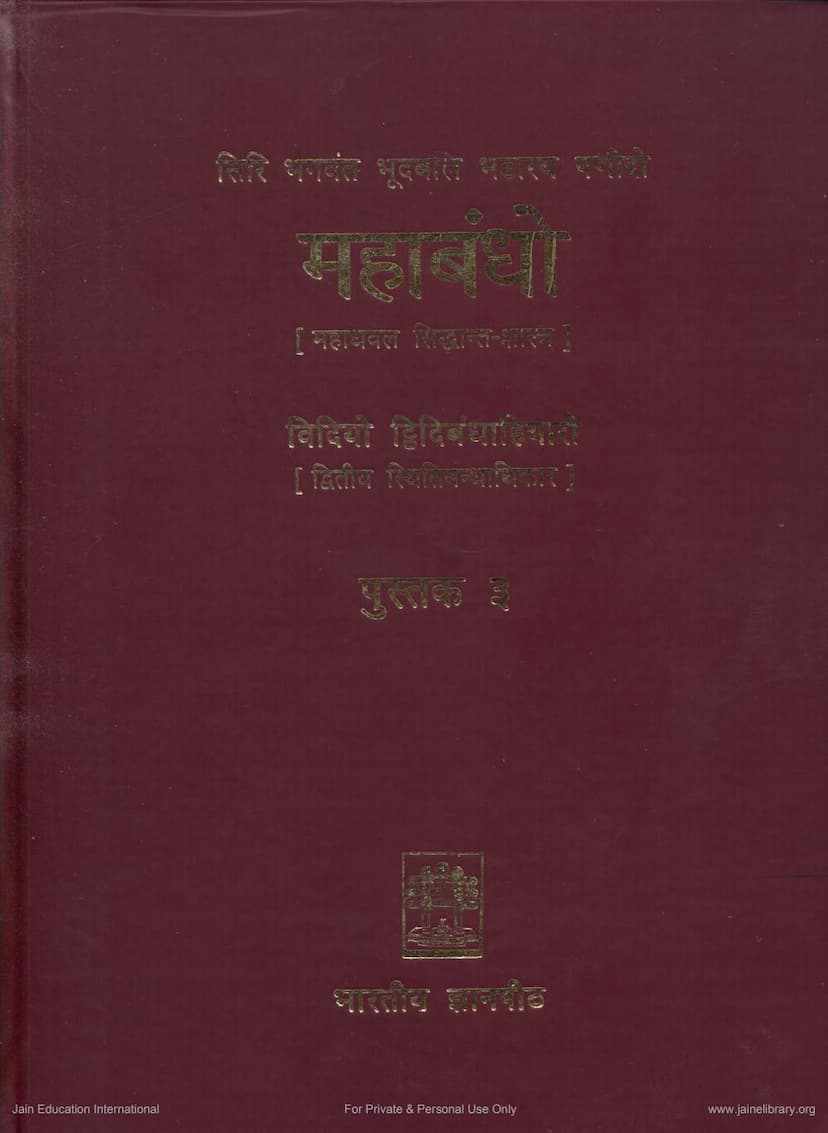Mahabandho Part 3
Added to library: September 2, 2025

Summary
This is a summary of Mahabandho, Part 3 (Dvitiya Sthiti-bandhadhikara), authored by Bhagvan Bhutabali and edited/translated by Pt. Phoolchandra Siddhantashastri, published by Bharatiya Jnanpith. This third volume of the Mahabandha text, which is the sixth khanda of the Satkhandagama and an integral part of the Agamas, delves into the philosophical subject matter of Karma-bandha.
Here's a breakdown of the key aspects covered in the text based on the provided pages:
Core Content:
- Mahabandho (Mahadhavala): This is identified as the sixth khanda of the Satkhandagama, a fundamental text within Jain Agamas.
- Dvitiya Sthiti-bandhadhikara (Second Part: Sthiti-bandhadhikara): This specific volume focuses on the 'Sthiti-bandhadhikara,' which deals with the duration or 'state' of karmic bondage.
- Bhagvan Bhutabali: The original author, whose explanations of the philosophical subject matter of Karma-bandha in Sauraseni Prakrit are presented in seven volumes.
- Pt. Phoolchandra Siddhantashastri: The editor and translator who has made this classic text accessible with Hindi translation.
Publisher and Series:
- Bharatiya Jnanpith: The publisher, a significant institution dedicated to researching, editing, and publishing Jain literature in various ancient languages with modern translations.
- Moortidevi Jain Granthamala: This work is part of this Granthamala series, aiming to publish diverse Jain literature.
Editorial Notes and Key Points from the Text:
- Textual Accuracy and Translation: The editorial note highlights that a word 'ched' (Kādavvam) occurs in several places and is translated as 'would say' or 'will be said.' It suggests that in many instances, the reading should be corrected to 'ched' (Kādavvam) for proper meaning, and the text might provide corrected readings in square brackets.
- Prakrit Phonology: The text touches upon Prakrit phonology, specifically the tendency for 'e' and 'o' to be reduced and softened, a pronunciation peculiarity noted in certain Vedic schools. It also mentions the change in pronunciation of 'deva' to 'daiva' and the transformation of 'u' to 'o' in certain word groups.
- Punctuation for Pronunciation: A notable change in this edition is the introduction of punctuation marks (e.g., ě, ō) to indicate the correct pronunciation of reduced vowels.
- Collaboration and Support: The editorial notes express gratitude for the support received from individuals and institutions like Bandhu Ratan Chandra Ji Mukhtar, Bandhu Nemichandra Ji Vakil, and the Bharatiya Jnanpith, emphasizing the importance of societal contribution to preserving and publishing such valuable texts.
- Importance of Jain Literature: The editor stresses the immense significance of these texts within the Digambara tradition, their direct link to the Twelve Angas of Jain scripture, and the societal duty to protect and study them, drawing parallels with devotion to deities.
- Historical Significance: The preface mentions the historical importance of a 'prashasti' (inaugural inscription) found at the end of the Sthiti-bandha section, which details the lineage and contributions of several individuals.
Content Summary (from the detailed table of contents and snippets):
The book, specifically the second part of the Sthiti-bandhadhikara, appears to cover intricate details of karma bondage, focusing on the 'Sannikarsa' (conjunction or association) of different types of souls with various karmas. The chapters listed in the table of contents suggest a comprehensive analysis of:
- Bandha-sannikarsa: The conjunction of karma bondage. This is broken down into:
- Types of sannikarsa (Jaghanya - inferior, Utkrishta - superior).
- Classification of superior sannikarsa (Swasthana - in one's own state, Parasthana - in another's state).
- Detailed analysis of sannikarsa based on permutations and combinations of souls, karma types, their durations (sthiti), intensity of feeling (bhava), quantitative aspects (parimana), location (kshetra), touch (sparshana), time (kala), and intervals (antara).
- Bhag-vichaya (Analysis of Modes): Detailed analysis of various modes of karma bondage.
- Parimana-prarupana: Discussion on the quantum or measure of karma bondage.
- Kshetra-prarupana: Discussion on the location or realm of karma bondage.
- Sparshana-prarupana: Discussion on the quality or 'touch' of karma bondage.
- Kala-prarupana: Discussion on the time or duration of karma bondage.
- Antara-prarupana: Discussion on the interval or gap in karma bondage.
- Bhava-prarupana: Discussion on the states or sentiments (bhava) associated with karma bondage.
- Alpa-bahutva: Comparison of the numbers of souls in different states or experiencing different karmas.
- Bhujagarbandha, Vriddhibandha, etc.: Analysis of specific types of karma influx and their duration.
Overall Purpose:
The Mahabandho, particularly this volume, is a highly technical and philosophical text within Jainism, aiming to provide a deep and systematic understanding of the workings of karma, the causes of bondage, and the durations of these karmic influences on the soul. It meticulously details how different souls, in various states of existence and spiritual development, interact with different karmas, influencing the duration and nature of their bondage. The work is crucial for understanding the complex mechanisms of karma as explained by the Tirthankaras and Ganadharas.